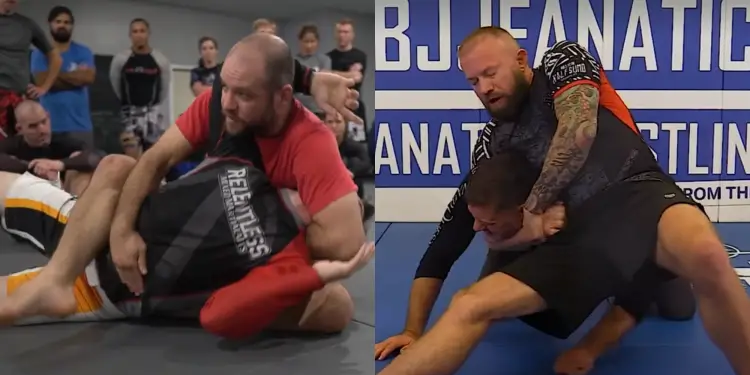Everyone knows the most common submissions in no gi BJJ, but what are the rarest submissions out there? The odds of seeing an armbar, rear-naked choke, or heel hook in any given match are pretty high. So much so, that watching an entire event with a dozen or more matches means that you will probably see one of these finishes. There’s a few other submissions that you could watch out for in hundred of matches and never see even once, usually because they’re so hard to set up or they are only possible from very specific situations. They’re the submissions that we’ll be looking at now.
10 Of The Rarest Submissions In No Gi BJJ
Scorpion Crush
The Scorpion Crush (or Crunch) is a submission that is actually very old, and is referred to as Do-Jime in Judo terminology. It can only be set up from closed guard, so straight away that limits the amount of opportunities that competitors will have to use it. What makes it less likely to happen is the fact that it requires the bottom player to break down their opponent’s posture and reach behind their own legs with both hands. Despite how difficult that is to do, the Scorpion Crush has still been seen even at a Bellator event.
Suloev Stretch
The Suloev Stretch is another rare submission that has actually been seen in MMA, with Aljamain Sterling and Zabit Magomedsharipov famously both finishing UFC fights with it at the same event. It requires the attacked to have already taken their opponent’s back, and is usually set up when the defender turns to turtle and starts trying to stand up on all-fours. That allows the attacker to slide down towards the head slightly and reach for their opponent’s leg, pulling it towards them and applying a brutal stretch to the hamstring.
Bulldog Choke
The bulldog choke is actually the fastest way to put an opponent to sleep according to a recent study, but it’s far more difficult to set up than most other chokes. The top player needs to be attacking a turtled opponent and they need a small window of opportunity where the opponent looks up, allowing them to lace an arm under their neck. It can also be transitioned to when an opponent escapes both hooks while still being stuck in a rear-naked choke. From there, the attacker is in a position to apply tremendous pressure and many people will tap to the brutal neck-crank even before the choke takes effect.
Von Flue Choke
The Von Flue Choke is named after UFC veteran Jason Von Flue, as he is the one who popularised it by putting an opponent to sleep with it at UFC Fight Night 3 in 2006. It’s a very specific technique that can only be used in one scenario, when an opponent is attempting a guillotine choke. The attacker then passes to side control, or sometimes half-guard, and keeps the choking arm trapped in the process. They then drive their shoulder into their opponent’s neck, applying the choke in the process. The specific nature of the Von Flue Choke makes it very rare at the highest level, as grapplers will almost always abandon the guillotine far earlier.
Arm-in Rear-naked Choke
The arm-in rear-naked choke goes by several names and has recently gained some traction as the ‘Rouotolotine’ after both of the Ruotolo brothers won their matches at ONE Fight Night 21 using the same technique. All it requires is for the attacker to take the opponent’s back, or set it up in the process of moving to the back. What makes it so rare is that it’s a very difficult technique to master. Mechanically it’s actually much more similar to a D’arce choke, even though it looks at first to be simply a rear-naked choke with an arm included.
Cry-angle Choke
The cry-angle choke is actually a variation of the triangle choke, where the opponent’s leg is caught within the triangle as well as their arm. It’s notoriously difficult to set up and is most often seen from 50/50, where the opponent’s leg is already trapped, or in a scramble during a passing sequence. The trapped arm and leg make it virtually impossible to escape though, so once it is locked up it’s almost always finished. Ryan Hall made it more well-known in his instructionals, and Taylor Pearman famously used it to finish an opponent in a major tournament.
No Gi Baseball Bat Choke
The no gi baseball bat choke is one of the few submissions on this list of the rarest in BJJ that is actually done from a pretty common position. All the technique requires is for the attacked to be in top side control, and have access to the opponent’s neck. Although that can be difficult at times, it’s something that elite grapplers are able to do pretty often. From there, the attacker puts their arms on either side of their opponent’s neck and interlocks their fingers before closing the gap between their elbows to apply the choke. The weakness of the grip between fingers is exactly what makes this such a rare submission.
Executioner
The executioner is often called the Dragon Sleeper Hold, thanks to it’s frequent use in professional wrestling events like WWE. It can be done from back control but is incredibly difficult to set up from there as it requires the attacker to reach all the way over the top of their opponent’s head. It’s more commonly seen from a north-south choke position, where the attacker can lift their opponent up slightly and take the back with the executioner already locked in. It’s one of the rarest submissions in no gi BJJ but it’s also one of the most devastating, as it applies brutal pressure on the opponent’s neck and spine.
No Gi Ezekiel Choke
The no gi ezekiel choke is very rare in general, although you wouldn’t think it if you’d ever seen Aleksei Oleinik fight. The Russian MMA veteran has had 80 professional fights and has finished 14 of them with this unique submission. He’s a true master of it, but there’s very few people in the world who can pull it in high-level competition besides him. It can be done from either side of mount or closed guard, and it requires the attacker to place their arms behind and in front of the opponent’s neck and interlock them in order to squeeze for the finish.
Peruvian Necktie
Like the arm-in rear-naked choke, The Peruvian necktie belongs to a pretty large family of submissions; head and arm chokes. It earned it’s name thanks to Tony de Souza, the Peruvian UFC veteran who is credited with it’s invention. It’s most often set up from the front-headlock and the attacker needs to connect their hands around the opponent’s head and arm, before squatting above them and swinging the leg over their back. The reason this is one of the rarest submissions in no gi BJJ is likely because there are far more reliable techniques available from the exact same position, that also require a similar initial setup.













